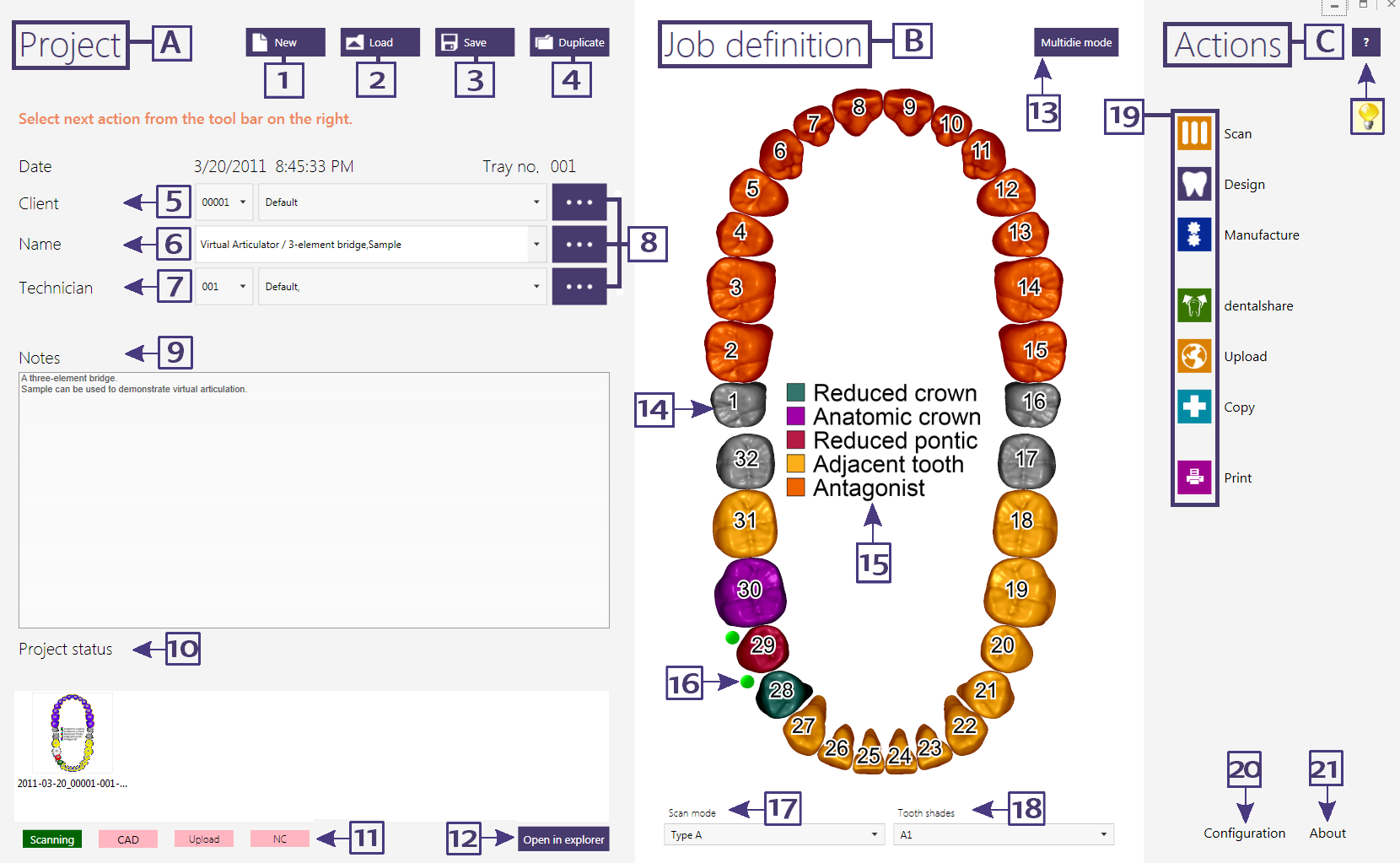WIN 8 DB
The entry point to the CAD/CAM platform is the DentalDB module. There are 3 sections that you define your Project A(dentist, patient, technician),Job defenitions B (type of constructions and the materials)and Actions C ( tasks to finalize your CAD/CAM work: Scanning, Design, Manufacture and Upload of construction data or milling).
Contents
Getting started
After startup, the following screen is presented to you:
| A short help [?] in the upper right, in the Actions section [C] , will guide you step-by-step in this exocad wiki website |
Defining Project details
To define your project, proceed as follows:
- Select the Client (dentist/ lab) [5]. You can either select the client number or the client name; the respective other field will update accordingly.
- To add a new Client, Name or Technician to the database, click button[8]( edit function) – a dialog will open that allows you to view your list of clients, names , and technicians respectively.
| In the Client window at the client ID pulldown[1], you can start typing the first characters of a client name, and the selection will autofill ("typeahead find") |
- Enter a name of the patient or project ID [6]
| You can also type in a new patient name in the field [6] – the new name will automatically be added to the database as soon as you save your job. |
- Select technician[7] (the same way as you select the client)
- Notes field, add additional information here [9].
The Project status pane
For saved jobs, an image preview panel [10] is available. After the scan process, preview photos of the models may be visible here, including screenshots from CAD and 3D pdf files.
| You can use Drag & Drop functionality to add additional images of your choice. E.g. you can drag and drop patient photos from a digital camera or from your email client directly here [10]. Double-click an image thumbnail to open it in your favorite image viewer, right-click it to access its context menu (the same menu that is available for the image in Windows Explorer) |
Defining Job definition section
- Select the restorations and materials by clicking on the tooth bows [14] – see "Choosing tooth restoration types" for details. Colors are used to mark different types of restorations in the tooth bow; an index is available [15].
- To use an antagonist scan, select "Antagonist" for at least one tooth in the opposing jaw, and define the type of antagonist scan/ scan mode using [17]
Definitions of Scan mode may vary depending on your configuration and are as follows:
- Bite Impression - Scanning a bite registration in position on the model.
- Registered Jaw(without articulator) - Scanning of both models which have been registered together ( wax, glue, elastic bands...etc.)
- Type A,Type S , Adjustable, Type P - Scanning of Models which have been mounted on a semi-adjustable articulator on the bench either using a facebow registration or any other means of articulation. This is only available with the Articulator Module. See Articulator Module
| The transference of the facebow position or another means of articulation can be translated by the use of exoScan. |
- Define connectors using the toggle buttons [16].
- Green: A connector will be created between the teeth
- Grey: A connector will not be created between the teeth (click to toggle)
- Red: A connector may not be created, because the material of the adjacent teeth differs
- No toggle button present: One of the selected types does not permit connectors
By default, connectors will be defined automatically whenever you define a pontic. So in practice, you will use this feature mostly to add connectors between adjacent crowns or copings.
- You may also select tooth shade [18] or other job details (depending on your configuration, options like express shipping from the milling center may be available).
- Multidie Mode/ Patient Mode [13] defines the scanning process from using a multidie plate or model based scanning
Saving and starting
To begin with a new job click on the New button[1] To load a job that was previously entered click on the Load button[2] Once your job is defined, click the Save button [3] to save your job. This will add the job details to the database, and create a project folder which will hold all the data (scans, constructions, project file) related to this job.
- Duplicate [4] (copying job information/scan data/construction data and saving it in a new project)
Once the job has been saved, additional buttons in the Action section [C] become available: You may now start the scanning process using the "Scan" button[19], and then start the CAD construction using the "Design" button[19], or print job details using "Print"[19].
Note that content of the Actions section[C] icons for the various actions, may vary depending on your system configuration.
Buttons in the Actions section [C] in [19]
- Upload uploading a job to the production center (once the construction has been completed)
- Manufacture launching the CAM module or the machine control software
- Dentalshare sending and receiving of exocad project files on the cloud network
- other features offered by your system vendor may be available on your setup
The red/green indicators [11] give you an overview which actions have already been performed. Green color means that this stage of the process (Scanning, CAD, etc) has been completed. To open the respective project directory in Windows Explorer, click the "Open in Explorer" button [12].
Loading saved jobs
To load a job, click "Load" in the Project section[A] button[2]. See the "Loading Jobs" section for details.
Changing user interface language and tooth numbering scheme
Configuration button [20] opens a configuration dialog which allows you to change the language of the user interface, and switch between FDI tooth numbering (11-48), Palmer notation (quadrant) and Universal Numbering System (1-32, US).
